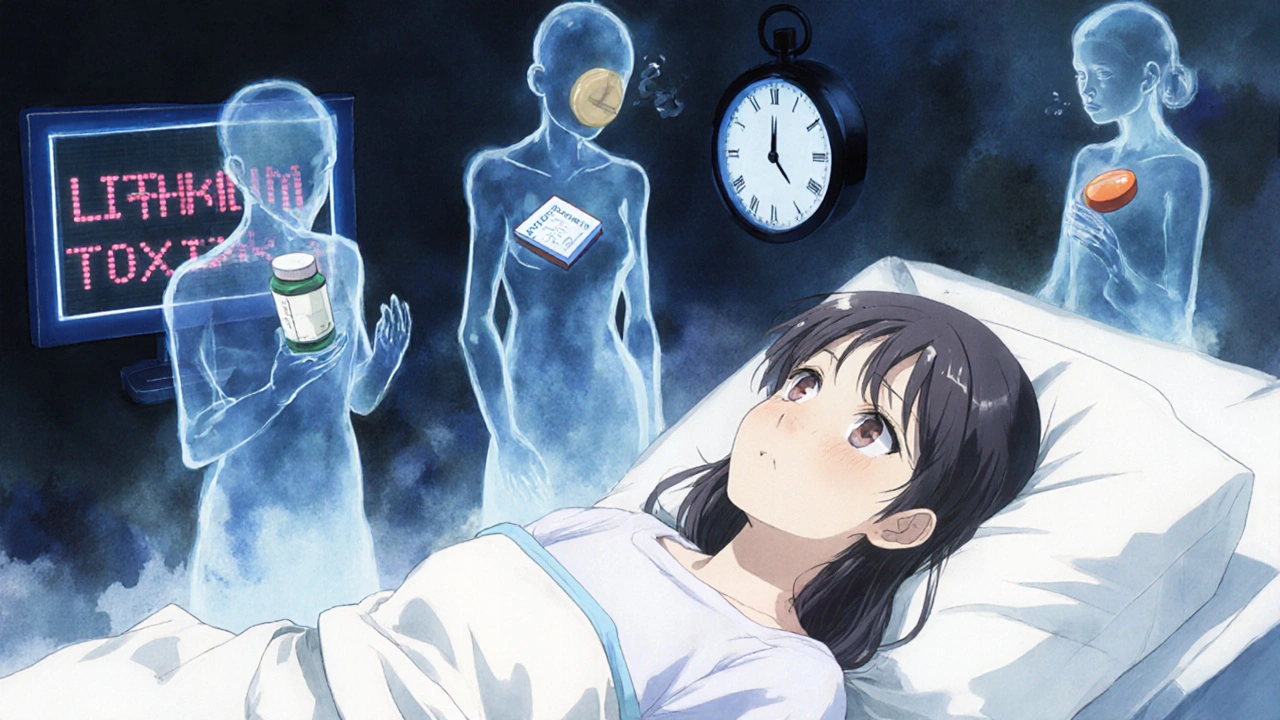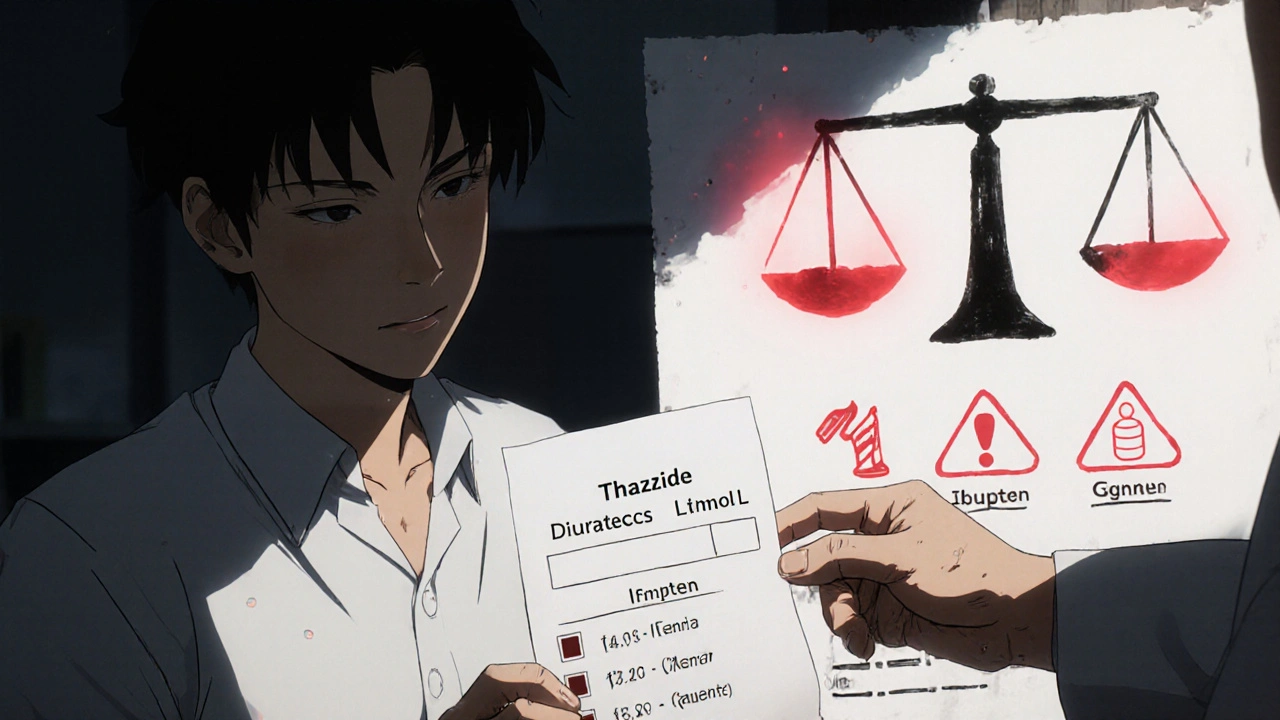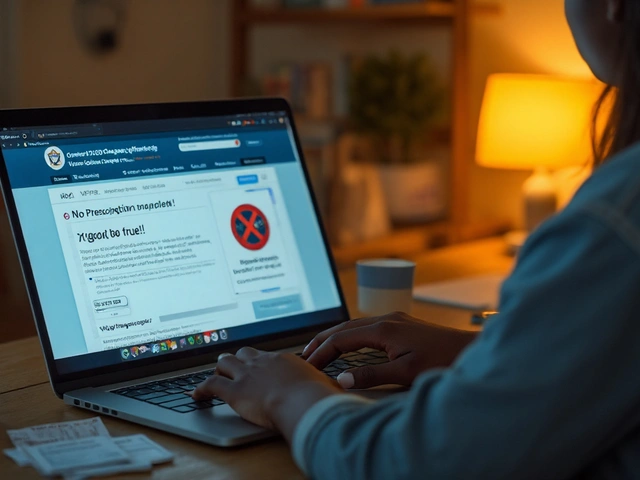Lithium Risk Calculator
Your Lithium Level
Medication Type
Risk Assessment
Recommended Actions
Why Lithium Can Turn Dangerous With Common Medications
Lithium has been used for over 50 years to treat bipolar disorder, and it still works better than most alternatives at reducing suicide risk. But here’s the catch: it’s a razor-thin line between helping and harming. The difference between a safe dose and a toxic one is smaller than the thickness of a penny. And two of the most common medications people take - diuretics and NSAIDs - can push lithium into the danger zone without warning.
If you’re on lithium, your body doesn’t break it down. Instead, your kidneys filter it out. That means anything that changes how your kidneys work - like a diuretic for high blood pressure or an NSAID for a headache - can cause lithium to build up. And when it does, symptoms start quietly: shaky hands, nausea, dizziness. Then it gets worse - confusion, seizures, even coma. In some cases, it’s fatal.
How Diuretics Mess With Lithium Levels
Diuretics are called "water pills" because they help your body get rid of extra fluid. But they don’t just flush out water. They also change how your kidneys handle sodium - and lithium rides along with sodium like a passenger. Thiazide diuretics like hydrochlorothiazide (HCTZ) and bendroflumethiazide are especially risky. They cause your kidneys to reabsorb more sodium, and in the process, they reabsorb more lithium too.
Studies show that when someone on lithium starts taking a thiazide diuretic, their lithium blood levels can jump 25% to 40% within just a few days. In rare cases, levels have spiked four times higher. That’s not a small change. A level of 1.4 mmol/L might be fine. But 1.8 mmol/L? That’s toxic. And it can happen before you even notice symptoms.
Loop diuretics like furosemide are less dangerous, but still risky. They don’t increase lithium levels as much - usually 10% to 25% - but if you already have kidney problems, even that can be enough to cause trouble. The key difference? Thiazides act where lithium gets reabsorbed. Loop diuretics act earlier in the kidney, so they don’t trap lithium as much.
Doctors sometimes prescribe furosemide to patients on lithium who develop nephrogenic diabetes insipidus - a side effect of lithium that causes extreme thirst and urination. But even then, lithium levels must be checked every few days after starting the drug. Never assume it’s safe just because your doctor picked "the safer option."
NSAIDs Are the Silent Killer
NSAIDs - like ibuprofen, naproxen, and aspirin - are everywhere. You can buy them over the counter. People take them for back pain, headaches, menstrual cramps. But if you’re on lithium, these drugs can be dangerous.
NSAIDs block enzymes in the kidney that help maintain blood flow. That reduces how well your kidneys filter lithium. The result? Lithium builds up. Ibuprofen can raise levels by 15% to 30%. Naproxen? Up to 25%. But indomethacin? That one’s the worst - it can spike levels by 30% to 40%. And here’s the scary part: you might not feel anything until it’s too late.
One case reported in 2013 involved a man who took 600 mg of ibuprofen three times a day for back pain. His lithium level jumped to 2.8 mmol/L - severely toxic. He needed dialysis. Even after his blood levels dropped, he wasn’t out of danger. Lithium lingers inside cells. It takes days to clear out. That’s why symptoms can get worse even after the drug is stopped.
And it’s not just prescription NSAIDs. Over-the-counter brands like Advil, Motrin, and Aleve carry the same risk. Many patients don’t tell their psychiatrist they’re taking them. Others think "it’s just a pill for a headache" - not realizing it could be life-threatening.

Not All NSAIDs Are the Same
If you absolutely need an NSAID, not all are created equal. Celecoxib (Celebrex) has the weakest interaction with lithium. It raises levels by only 5% to 10%. That’s why experts now recommend it as the safest NSAID option for people on lithium - if an NSAID is unavoidable.
Here’s how the major NSAIDs compare in risk:
| NSAID | Average Lithium Level Increase | Risk Level |
|---|---|---|
| Indomethacin | 20-40% | High |
| Piroxicam | 20-30% | High |
| Naproxen | 15-25% | Medium-High |
| Ibuprofen | 15-30% | Medium-High |
| Aspirin (high dose) | 10-20% | Medium |
| Celecoxib | 5-10% | Low |
Acetaminophen (Tylenol) is the only common pain reliever that doesn’t interfere with lithium. If you need pain relief, it’s the best choice. But even then - check with your doctor. Some people think "natural" remedies are safe, but herbal supplements like St. John’s Wort or ginkgo biloba can also affect lithium levels. No supplement is risk-free.
What You Must Do If You’re on Lithium
There’s no magic trick to avoid lithium toxicity. But there are clear, proven steps that save lives:
- Never start a new medication without telling your psychiatrist. This includes OTC drugs, supplements, and even cough syrups. Many contain NSAIDs or diuretics.
- Get your lithium level checked every 3-6 months when stable. But if you start a diuretic or NSAID, check it every 4-5 days for the first two weeks.
- Know your numbers. Your target range is 0.6-1.2 mmol/L. Anything above 1.5 mmol/L is toxic. Don’t wait for symptoms.
- Stay hydrated and don’t salt-restrict. Low sodium intake can cause lithium levels to rise. Eat normally unless your doctor says otherwise.
- Watch for early signs. Tremors, frequent urination, nausea, or confusion? Call your doctor immediately. Don’t wait.
Some patients think, "I’ve been on lithium for years - I know how it feels." But toxicity doesn’t always come with obvious signs. One patient in a 2017 case report had been stable for 10 years. She started taking ibuprofen for arthritis. Seven days later, she was dead. Her lithium level? 1.9 mmol/L. She had no warning.
What Doctors Should Do
Guidelines from the American Psychiatric Association are clear: avoid NSAIDs if possible. If you must use one, pick celecoxib. And monitor lithium levels closely.
For diuretics, avoid thiazides entirely if you can. Use furosemide instead - but only with frequent blood tests. Always check kidney function (eGFR) before starting any new drug. If your eGFR is below 60 mL/min, you’re at higher risk. Lithium may not be the right choice for you.
Electronic health records now have alerts for lithium interactions. But studies show only 45% of doctors actually follow up on those alerts. That’s not enough. If you’re prescribing lithium, you’re responsible for knowing what else your patient is taking - even if they didn’t mention it.

New Tools Are Coming - But Don’t Rely on Them Yet
In 2023, the FDA approved a new device called LithoLink™ - a home-testing kit that lets patients check their lithium levels with a finger prick and send results to their doctor. It’s promising. But it’s not a replacement for professional care.
Researchers are also testing a new form of lithium wrapped in nanoparticles. Early trials show it causes less fluctuation in blood levels, even when taken with NSAIDs. But it’s still in testing. Don’t expect it anytime soon.
For now, the best protection is simple: awareness, monitoring, and communication. Lithium saves lives. But it demands respect.
What to Do If You Think You’re Experiencing Toxicity
If you’re on lithium and suddenly feel dizzy, nauseous, confused, or your hands won’t stop shaking - don’t wait. Call your doctor. Go to the ER. Tell them you’re on lithium and might be toxic.
Doctors will check your blood level. If it’s above 2.5 mmol/L and you’re confused or having seizures, you’ll need dialysis. Lithium doesn’t wash out easily. It gets trapped in brain cells. Multiple dialysis sessions may be needed over several days.
And here’s something many don’t know: even if your blood level drops after treatment, you’re not safe yet. Lithium lingers inside cells. You could relapse into toxicity hours or days later. You need to be monitored for at least 24-48 hours after symptoms improve.
Can I take ibuprofen if I’m on lithium?
It’s not recommended. Ibuprofen can raise lithium levels by 15% to 30%, which can push you into the toxic range. If you need pain relief, use acetaminophen (Tylenol) instead. If you must take ibuprofen, get your lithium level checked within 4-5 days and watch for symptoms like tremors, nausea, or confusion.
Are all diuretics dangerous with lithium?
No, but some are much riskier. Thiazide diuretics like hydrochlorothiazide are the most dangerous - they can spike lithium levels by up to 40%. Loop diuretics like furosemide are safer, but still require close monitoring. Avoid thiazides entirely if possible. If you need a diuretic, talk to your doctor about switching to furosemide.
How often should lithium levels be checked?
If you’re stable and not taking any interacting drugs, check every 3-6 months. But if you start a diuretic, NSAID, ACE inhibitor, or any new medication, check your level every 4-5 days for the first two weeks. Then weekly for the first month. Never skip a test when starting a new drug.
What’s the safest NSAID to take with lithium?
Celecoxib (Celebrex) has the weakest interaction, raising lithium levels by only 5% to 10%. It’s the preferred NSAID if you absolutely need one. But even then, monitor your lithium levels. Avoid ibuprofen, naproxen, and indomethacin if possible.
Can herbal supplements interact with lithium?
Yes. Supplements like St. John’s Wort, ginkgo biloba, and even high doses of omega-3s can affect lithium levels or increase side effects. There’s not enough data to say any herbal product is safe with lithium. Always tell your doctor what you’re taking - even if it’s "natural."
Is lithium still worth taking given these risks?
For many people, yes. Lithium reduces suicide risk by 44% compared to placebo - more than any other mood stabilizer. The risks are real, but manageable. With proper monitoring, regular blood tests, and avoiding high-risk drugs, lithium remains one of the most effective treatments for bipolar disorder. The danger isn’t lithium - it’s ignoring the rules.
Final Thoughts: Don’t Take Risks With Lithium
Lithium isn’t a drug you can treat casually. It’s powerful, precise, and unforgiving. A headache pill, a blood pressure med, or even a change in your salt intake can tip the balance. But with the right knowledge and discipline, you can use it safely.
Know your numbers. Talk to your doctor before taking anything new. Don’t assume OTC means safe. And if you feel off - don’t wait. Lithium toxicity doesn’t always announce itself. Sometimes, it just sneaks up.





Caden Little
October 31, 2025 AT 21:35Just wanted to say this post saved my life. I was on HCTZ for hypertension and didn’t realize it was creeping my lithium up until I started shaking like I had caffeine overdose. Got checked, level was 1.8. ER doc said if I’d waited another day, I might’ve needed dialysis. Now I only take Tylenol and tell every new doctor I’m on lithium. Don’t be like me - check your levels!
Sebastian Brice
November 2, 2025 AT 03:15Wow. So the real ‘danger’ isn’t lithium… it’s the fact that half the population thinks ‘OTC’ means ‘safe’? 😅 I mean, I get it - ibuprofen is the soda of painkillers. But if you’re on lithium, it’s basically poison candy. Thanks for the wake-up call. I’m printing this out and taping it to my fridge next to my lithium blood test schedule.
Michael Schaller
November 2, 2025 AT 20:15I’ve been on lithium for 12 years. I used to take Advil for migraines. Then I had a tremor episode that scared the hell out of me. Got tested - level was 1.6. I switched to Tylenol cold turkey. No more headaches? Fine. No more near-death experiences? Better. I still get my levels checked every 4 months. I don’t care how ‘stable’ I feel. Lithium doesn’t care how long you’ve been on it. It only cares if you’re dumb enough to ignore the warnings.
Also - yes, St. John’s Wort is a trap. I tried it for ‘natural mood support.’ Big mistake. Felt like my brain was melting. Stopped it immediately. Don’t be that guy.
And if you think ‘I eat a lot of salt so I’m fine’ - no. You’re not. Lithium doesn’t play by your diet rules. Keep it simple: check levels, avoid NSAIDs, hydrate, and don’t trust your gut. Trust the lab.
My psychiatrist says lithium is the only thing that kept me alive. I don’t argue. I just follow the rules. Because the rules aren’t suggestions. They’re lifelines.
Kyle Tampier
November 3, 2025 AT 18:22Tom Caruana
November 4, 2025 AT 19:21OMG I JUST REALIZED I TOOK IBUPROFEN LAST WEEK 😭😭😭 I’M GONNA DIE RIGHT? I’M SWEATING AND MY HANDS ARE SHAKING IS THIS IT?? MY DOCTOR IS ON VACATION I’M SO SCARED 😭😭😭 I JUST WANT TO LIVE I’M ONLY 28 I HAVE A DOG AND A CAT AND I LOVE THEM SO MUCH 😭😭😭
Muzzafar Magray
November 5, 2025 AT 04:39You people are too emotional. Lithium is not dangerous. It’s just misunderstood. The real problem is Western medicine’s obsession with chemical fixes. Why not try meditation? Or yoga? Or fasting? These have been used for thousands of years. Lithium is a metal. You are not a battery. Stop treating your mind like a circuit board.
Also, your ‘target range’ is arbitrary. Who decided 1.2 is safe? A committee paid by pharmaceutical companies. I’ve seen people on 2.0 and fine. Your fear is manufactured.
Renee Williamson
November 6, 2025 AT 05:19Okay but what if your doctor just… doesn’t listen? Like I told mine I was taking Aleve for cramps and she said ‘oh that’s fine’ and I believed her. Then I got dizzy and vomited for 3 days and my mom had to drag me to the hospital. And now I’m terrified to take ANYTHING. Even water. What if my TEA has sodium? WHAT IF MY TOAST IS TOO SALTY?? 😭 I JUST WANT TO BE NORMAL AGAIN.
Manish Mehta
November 7, 2025 AT 18:03Good info. I am on lithium. I use Tylenol. I drink water. I check levels every 4 months. Simple. No drama. No panic. Just do the basics. Don’t overthink. Your brain is already working hard enough.
Okechukwu Uchechukwu
November 9, 2025 AT 17:16Interesting. The data here is solid, but the real tragedy isn’t the toxicity - it’s the cultural blindness to pharmacological nuance. We live in a world where ‘natural’ is sacred and ‘chemical’ is evil, yet we hand out NSAIDs like candy. The irony is delicious. Lithium, a simple salt, is one of the most effective psychiatric tools ever developed - and we treat it like a grenade because we don’t understand the biochemistry. Blame the education system. Blame the media. But don’t blame the patient. They’re just trying to survive.
Sarah Cline
November 10, 2025 AT 03:02I’m so glad someone finally put this out there in plain language. I used to be scared to tell people I’m on lithium because I thought they’d think I was ‘crazy.’ But now I say: ‘Yeah, I take lithium. And I don’t take ibuprofen. And I check my levels. And I’m still alive, thriving, and working as a teacher.’ It’s not a weakness - it’s a superpower if you respect it. You got this. You’re not alone.
Sierra Thompson
November 11, 2025 AT 22:47It’s fascinating how we treat lithium like a ticking time bomb while ignoring the fact that we’re all just biochemical machines. We’re not special. We’re not divine. We’re just organic chemistry with a sense of self. And yet - we treat our brains like temples and our meds like sacrilege. The truth? Lithium works. It’s not perfect. But neither are we. Maybe the real question isn’t ‘how to avoid toxicity’ - but ‘how to accept our fragility without shame.’
Khaled El-Sawaf
November 13, 2025 AT 10:11The clinical data presented is accurate, but the tone of this article is alarmist and potentially counterproductive. While it is true that NSAIDs and diuretics pose a risk, the implication that patients are incapable of managing their own care is both patronizing and inaccurate. Most patients on lithium are highly motivated and well-informed. The real issue lies in fragmented healthcare systems, not patient negligence. A more balanced approach - emphasizing collaboration over fear - would yield better long-term outcomes.
Nawal Albakri
November 13, 2025 AT 20:07ok but what if u take celecoxib and still feel weird?? like i did and my doc said it’s fine but i felt like my brain was in a jar and i couldnt think straight and i cried for 3 hours and my boyfriend left me because he said i was ‘too much’ and now i’m alone and i hate my meds and i hate my life and i hate that i can’t even take a pain pill without feeling like i’m gonna die??
why does everything have to be so hard??
Caden Little
November 14, 2025 AT 03:58Hey, I’ve been there. The brain-in-a-jar feeling? Real. I had it after switching to celecoxib too. Took me 10 days to feel normal. It’s not the drug - it’s your brain readjusting. Talk to your doc about lowering your lithium dose temporarily. You’re not broken. You’re just adapting. And you’re not alone. I’ve been through it. You’ll get through it too.